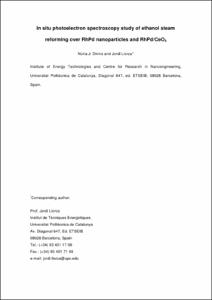Mostra el registre d'ítem simple
In situ photoelectron spectroscopy study of ethanol steam reforming over RhPd nanoparticles and RhPd/CeO2
| dc.contributor.author | Jiménez Divins, Nuria |
| dc.contributor.author | Llorca Piqué, Jordi |
| dc.contributor.other | Universitat Politècnica de Catalunya. Institut de Tècniques Energètiques |
| dc.date.accessioned | 2016-07-28T09:59:55Z |
| dc.date.available | 2018-05-05T00:30:36Z |
| dc.date.issued | 2016-05-25 |
| dc.identifier.citation | J. Divins, N., Llorca, J. In situ photoelectron spectroscopy study of ethanol steam reforming over RhPd nanoparticles and RhPd/CeO2. "Applied catalysis A. General", 25 Maig 2016, vol. 518, p. 60-66. |
| dc.identifier.issn | 0926-860X |
| dc.identifier.uri | http://hdl.handle.net/2117/89316 |
| dc.description.abstract | In situ X-ray photoelectron spectroscopy (XPS) was carried out over model Rh0.5Pd0.5 nanoparticles and Rh0.5Pd0.5 nanoparticles supported on CeO2 following exposure to oxygen at 573-823 K, to hydrogen at 573 K (activation of the catalyst), to a mixture of ethanol and water at 823 K simulating ethanol steam reforming (ESR) conditions, and to hydrogen at 823 K. The presence of the CeO2 support had a strong influence on the atomic rearrangement and on the oxidation state of Rh0.5Pd0.5 nanoparticles. CeO2 exerted a quenching effect on the metal nanoparticles and limited atomic rearrangement under the different atmospheres tested except for ESR, where a partial segregation of Rh toward the surface of the nanoparticles was observed. When supported on CeO2, Rh0.5Pd0.5 nanoparticles were significantly more oxidized due to metal-support interaction. By comparing these in situ XPS results with a previous operando near ambient pressure XPS study conducted in a synchrotron facility at 0.05 mbar over the same samples, it is concluded that the information obtained for the unsupported Rh0.5Pd0.5 nanoparticles is similar in both cases, whereas Rh0.5Pd0.5 nanoparticles supported on CeO2 are clearly more oxidized and enriched in Pd in the volume sampled under operando ESR conditions compared to that obtained in the in situ experiments. The study of catalytic systems under operando conditions appears essential to identify the active species at work during ESR, as the restructuring driven by the reforming environment induces strong changes in their architecture. (C) 2015 Elsevier B.V. All rights reserved. |
| dc.format.extent | 7 p. |
| dc.language.iso | eng |
| dc.rights.uri | http://creativecommons.org/licenses/by-nc-nd/3.0/es/ |
| dc.subject | Àrees temàtiques de la UPC::Enginyeria química::Química orgànica::Compostos orgànics |
| dc.subject | Àrees temàtiques de la UPC::Física::Física de partícules::Fotons |
| dc.subject | Àrees temàtiques de la UPC::Física::Electromagnetisme::Raigs X |
| dc.subject.lcsh | Spectrum analysis |
| dc.subject.lcsh | Nanoparticles |
| dc.subject.lcsh | Photons |
| dc.subject.lcsh | Hydrogen |
| dc.subject.other | XPS |
| dc.subject.other | Ethanol steam reforming |
| dc.subject.other | Hydrogen |
| dc.subject.other | Ceria |
| dc.subject.other | Bimetallic nanoparticles |
| dc.subject.other | Hydrogen-production |
| dc.subject.other | Bio-ethanol |
| dc.subject.other | Soot combustion |
| dc.subject.other | Catalysts |
| dc.subject.other | Pd |
| dc.subject.other | Generation |
| dc.subject.other | Ceria |
| dc.title | In situ photoelectron spectroscopy study of ethanol steam reforming over RhPd nanoparticles and RhPd/CeO2 |
| dc.type | Article |
| dc.subject.lemac | Anàlisi espectral |
| dc.subject.lemac | Nanopartícules |
| dc.subject.lemac | Fotons |
| dc.subject.lemac | Hidrogen |
| dc.contributor.group | Universitat Politècnica de Catalunya. NEMEN - Nanoenginyeria de materials aplicats a l'energia |
| dc.identifier.doi | 10.1016/j.apcata.2015.08.018 |
| dc.relation.publisherversion | http://www.sciencedirect.com/science/article/pii/S0926860X15301137 |
| dc.rights.access | Open Access |
| local.identifier.drac | 18740469 |
| dc.description.version | Postprint (author's final draft) |
| local.citation.author | J. Divins, N.; Llorca, J. |
| local.citation.publicationName | Applied catalysis A. General |
| local.citation.volume | 518 |
| local.citation.startingPage | 60 |
| local.citation.endingPage | 66 |
Fitxers d'aquest items
Aquest ítem apareix a les col·leccions següents
-
Articles de revista [244]
-
Articles de revista [285]


